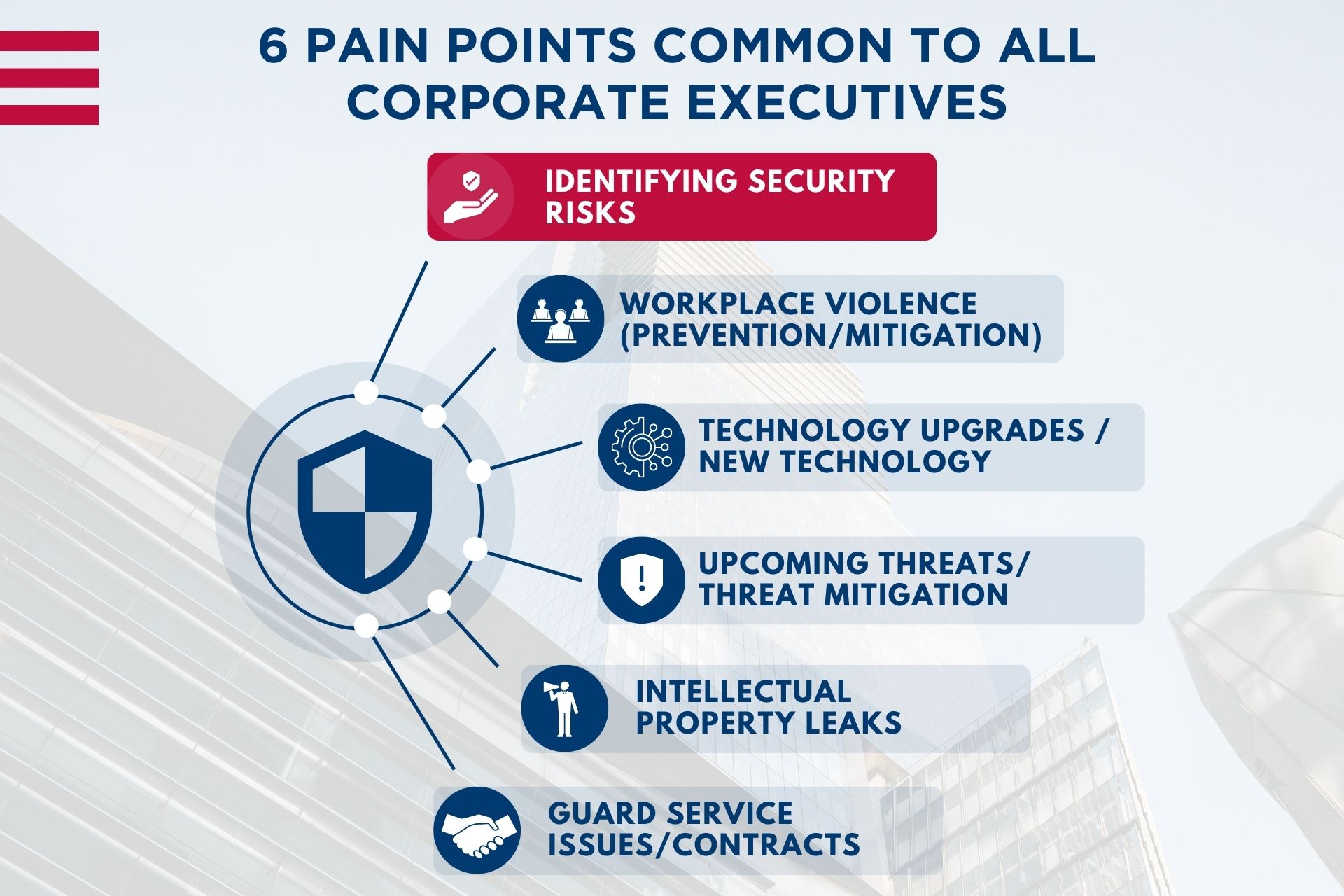
In today’s corporate America, security risks are a constant threat to organizations of all sizes and industries. With the increasing number of workplace violence incidents, cyber threats, data breaches, and natural disaster risks, identifying corporate risk has become a top priority for businesses of all sizes. The potential for harm is significant, and the consequences can be devastating. Organizations must be vigilant in identifying and mitigating risks to protect themselves, their customers, and their stakeholders. Identifying these risks can be a challenging task, especially for executives who may not have a technical background or feel overwhelmed.
In examining the issue, we have Identified six (6) pain points common to all corporate executives, and we will address each of them in this series. They are:
Today, we will discuss the first executive pain point; identifying security risks and make suggestions to overcome them. Let’s look at some key factors.
One of the most significant challenges executives face when it comes to identifying security risks is the lack of technical expertise. It is not uncommon for executives to have limited knowledge of cybersecurity and the various threats which exist within this arena. Additionally, physical security adaptations, new and emerging technology releases can be overwhelming and nearly impossible to stay current if not your primary focus. This can make it challenging to identify potential security risks and take appropriate action to mitigate them. Recognizing your limitations and bringing in an expert is the best solution. Never hope to handle the crisis once it becomes one.
Many executives in leadership roles often decide on having a risk assessment performed to identify risks, threats, and liabilities. While an assessment is a good practice to engage in, one must be very cautious about the use of them. I believe it is better to have a specific scope defined and review and address the issues it determines to be problematic. A wholesale, “find all the risks and liabilities” can cause many down range legal problems. Once you are aware of a potential liability, you have an obligation to mitigate it. While the ones identified within your purview may be addressable, some may not. It may be outside the scope of reason and budget to mitigate. Blast proofing the exteriors of a high-rise commercial office property in the center of the city would be excessive and beyond reason.
For executives, this is the lack of visibility into security practices within their organization. It can be challenging to know if employees are following security protocols and if the organization is adequately protected against risks and threats.
To address this issue, executives should establish clear security policies and procedures and ensure all employees are trained in them. They should also consider implementing security monitoring tools that can provide real-time visibility into security events and potential threats. Remember, a plan is not a “one and done” document but should be a dynamic tool pulled off the shelf and updated at least quarterly.
Budget constraints are also significant factors for executives when it comes to identifying risks and goes hand in hand with the assessments above. New and emerging technologies can be expensive, and many organizations may not have the resources to invest in the necessary tools and technologies to protect themselves adequately. What is worse, is most companies buy systems to protect themselves but never use the full capability of the technology. Either the systems were never fully activated, the training was never done or brushed over too quickly, or never used by staff. This is probably one of the biggest draws of a budget that is never recognized.
Don’t miss Part 2 of our 6 part series, we cover workplace violence, the key factors presented and some recommendations on how to prepare and attempt to mitigate these actions before they become a problem.
If you would like to discuss any of the pain points described above, we encourage you to call our office at 914-576-8706 to set up a free consultation session.
Don’t forget to subscribe to PCC Insights to get email notification when we post our next blog!

Unlock the full potential of your security and risk management with our expert-guided STAR Power Sessions. Get personalized coaching tailored to your organization’s unique needs. Don’t leave your business vulnerable – Book Your STAR Power Session Now!